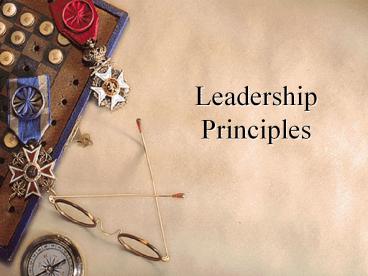Leadership Principles - PowerPoint PPT Presentation
1 / 32
Title:
Leadership Principles
Description:
Title: Training Last modified by: Department of defence Created Date: 5/29/1997 11:23:52 AM Document presentation format: On-screen Show Other titles – PowerPoint PPT presentation
Number of Views:81
Avg rating:3.0/5.0
Title: Leadership Principles
1
Leadership Principles
2
- Outline the role of a commissioned officer in the
Air Force - Describe the principles of leadership
- Describe the relationship between leadership,
management and command - Describe the OTS leadership model
3
Reference
- Army Manual of Land Warfare Vol 110
- The art of Eliciting Extraordinary Performance
from Ordinary People - LTCOL M.C. Parsons - Effective Leadership John Adair
4
References
- Training for Leaders, John Adair
- Leadership and the One Minute Manager
Blanchard - Leadership that gets results, Goleman, D.
(2000), Harvard Business Review, Mar Apr - Working with Emotional Intelligence, Goleman,
D. (1999), Bloomsbury Publishing, London.
5
A leader is the man who has the ability to get
other people to do what they dont want to do and
enjoy it Harry.
S. Truman, quoted in The Peoples Almanac (1975)
6
Leadership is the lifting of a mans vision to
higher sights, the raising of a mans performance
to a higher standard, the building of a mans
personality beyond normal limitations. Wishing
wont make it so doing will
Peter. F. Drucker, The Practise of
Management (1955)
7
I have to follow them, I am their leaderFrench
lawyer, politician and revolutionary leader
Alexandre Auguste Ledru-Rollin (1984)
8
The art of leadership..consists of consolidating
the attention of the people against a single
adversary and taking that nothing will split up
that attention
Adolf Hitler, Mein
Kampf (1925-26)
9
LEADERSHIP
- The art of consistently influencing and directing
subordinates in ways as to obtain their willing
obedience, confidence, respect and loyal
cooperation in the manner desired by the leader.
10
MANAGEMENT
- The process of planning, organising,
coordinating, controlling and evaluating the use
of people, money, materials and facilities to
accomplish missions and tasks.
11
COMMAND
- The lawful authority which an individual in the
Services exerts over subordinates by the virtue
of his/her rank and posting. Command is
supported by a code of military law.
12
LEADERSHIP
People Motivation Effectiveness
Resources Application Efficiency
Authority Responsibility Ethics
COMMAND
MANAGEMENT
MISSION
13
(No Transcript)
14
Early Leadership Theories
- Cave paintings as Training Aids
- Chinese writings of Confucius, Mo-tzu, Lao-tzu,
Sun-tzu - Early Eurpopean writers such as Homer,Plutarch,
Caesar, Machiavelli, Clausewitz
15
A leader is bestWhen people barely know he
exists,Not so good when people obey and acclaim
him,Worse when they despise him.But of a good
leader, who talks little,When his work is done,
his aim fulfilled,They will sayWe did it
ourselvesLao-Tzu, 6th century Chinese
philosopher
16
Modern Thought on Leadership
- The end of WW1 brought the demise of hereditary
leadership - First theories on personal qualities or traits
- After WW2, shift to observable behaviours
- 1960s - Situational leadership
- Recently - transactional to transformational
leadership
17
The PICSIE Crystal
18
Hershey-Blanchard Situational Leadership Model
19
The Emotional Competency Model
20
Coveys 7 Habits
- Habit One Be proactive
- Habit Two - Begin with the End in Mind
- Habit Three - Put First Things First
- Habit Four - Think Win-Win
- Habit Five - Seek First to Under- stand, Then to
be Understood - Habit Six - Synergise
- Habit Seven - Sharpen the Saw
21
(No Transcript)
22
The mastery of a model is not a substitute for
leadership.
23
In short, given the right context, every
leadership theory or model is the correct one.
24
The John Adair Leadership Model
25
LEADERSHIP
QUALITIES
ACTIONS
SKILLS
SELECTION
TRAINING
PRACTISE
26
QUALITIES
- Personal style and professional
qualities of a leader.
27
QUALITIES
- Personal style and professional
qualities of a leader.
- SKILLS
- Professional Skills
- Self-Improvement Skills
- Interpersonal Skills
- Communication Skills
- Ethics
28
QUALITIES
- Personal style and professional
qualities of a leader.
- SKILLS
- Professional Skills
- Self-Improvement Skills
- Interpersonal Skills
- Communication Skills
- Ethics
- ACTIONS
- Providing Vision
- Managing the Task
- Building the Team
- Supporting Individuals
- Adapting leadership style
29
Manage the task
VISION
Support the People
Build the Team
STYLE
30
LEADERSHIP TRAINING AT OTS
- INTRODUCTION
- Leadership Principles
- Leadership Development
SKILLS Professional Skills - other lessons at OTS
(ie CBRN) - goal setting Self Improvement -
(WEIP, MBTI) - Stress Management Interpersonal
Skills -Counselling Communication Skills Ethics
- ACTIONS
- Vision
- Manage the Task
- Build the Team
- Support the Individual
- Leadership Style
- QUALITIES
- Recruitment and selection
- QUAL 6 (Principles and Standards)
- Chaplain Lessons
- LEADERSHIP DEVELOPMENT
- PICSIE, Adairs model, Hershey-Blanchard,
Emotional Intelligence (Goleman), Coveys Seven
habits
- LEADERSHIP CONSOLIDATION
31
- Outline the role of a commissioned officer in the
Air Force - Describe the principles of leadership
- Describe the relationship between leadership,
management and command - Describe the OTS leadership model
32
Manage the task
VISION
Support the People
Build the Team
STYLE































